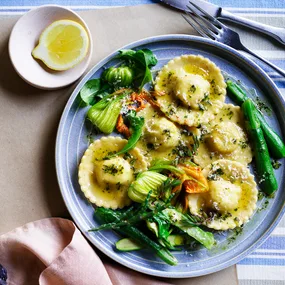“Basil originated in Asia and Africa but it is present all over the Mediterranean, and found a habitat in Italy in the climate and soil of Liguria,” explains Sydney’s Lucio Galletto. “It is there that the best of many varieties grow, and the Ligurian people learnt quickly how to use it gastronomically in the noblest way: pesto. This symbol of Ligurian cucina has very ancient origins: its roots are in an oriental sauce (Arabic or Persian) that was based on a mixture of pine nuts and fresh acidic cheese. Throughout the centuries, oil and basil were added to these ingredients, and the fresh cheese was substituted with grated parmesan and Pecorino because of the abundance of these ingredients in the region. The great debate is about the strength of the sauce: the amount of garlic used and the sharpness of the Pecorino. In the Riviera di Levante, near the Tuscan border (where this recipe is from), it is quite a mild sauce, and traditionally served with a durum wheat pasta such as trenette or spaghetti, with green beans and potatoes. Other types of pasta that can be served with pesto include trofie (little dumplings of wheat and chestnut flour, without egg) or gnocchi, mandili de sea (‘silk handkerchiefs’; very fine fresh rag pasta). Purists may insist on using a stone mortar and a wooden pestle, but today almost everybody uses a blender, which gives excellent results. It is essential, however, not to overheat the oil, as this ruins the aroma of the basil, so minimum speed and frequent pauses for cooling are necessary.”
Ingredients
Method
Main
Note Trenette is a narrow, flat pasta, thicker than linguine, that is traditionally served with pesto.
Notes










